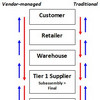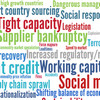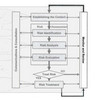 Resilience. A word that his been in the media perhaps more than ever before these days. I am of course thinking about the rescue of the Chilean miners and how it was possible for them to survive and emerge almost unaffected (as many of them seemed to be) after being trapped underground for 69 days. How is it possible that they adjusted and almost thrived in their adversity? Resilience is the answer. Resilience is what distinguishes those who fail from those who succeed, say Kathleen Sutcliffe and Timothy Vogus in Organizing for Resilience, a book chapter they wrote in 2003. Here they provide insights into why resilience is not something remarkable or extraordinary, but rather a result of an organizational learning process.
Resilience. A word that his been in the media perhaps more than ever before these days. I am of course thinking about the rescue of the Chilean miners and how it was possible for them to survive and emerge almost unaffected (as many of them seemed to be) after being trapped underground for 69 days. How is it possible that they adjusted and almost thrived in their adversity? Resilience is the answer. Resilience is what distinguishes those who fail from those who succeed, say Kathleen Sutcliffe and Timothy Vogus in Organizing for Resilience, a book chapter they wrote in 2003. Here they provide insights into why resilience is not something remarkable or extraordinary, but rather a result of an organizational learning process.
Logistics Resilience
The subject of today’s post did in fact not come to me as a response to the ongoing rescue operation in Chile, although I must admit that this event did serve as a catalyst for posting it now. It originally came to me some weeks ago when I was going over the references in the book Risicomanagement en Logistiek that I reviewed last week. In that book, resilience is a key ingredient in logistics risk management, and in that book I came across a couple of good references on resilience that I will share in the near future, this being the first.
A wicked problem?
What is resilience? According to Ken Simpson, resilience is a wicked problem, as he writes in one of his recent blog posts.
A ‘wicked problem’ is one that is almost impossible to solve, and where addressing some part of the perceived problem will often create adverse consequences in other areas.
Resilience is wicked, because it is open-ended.
To pursue building resilience in organisations we need to try something new, not simply apply the same old ideas. […] The wicked problem requires that we merge and blend different approaches to craft a solution […].
Resilience is thus not necessarily a result of predetermined plans and procedures (although they obviously will help part of the way). Resilience is a result of creativity meeting adversity.
Resilience is an acquired skill
Resilience is often referred to as the maintenance of positive adjustment under challenging conditions, and in organization theory, so the authors say, resilience usually refers to either one of two things:
– the ability to absorb strain and preserve functioning despite the presence of adversity
– the ability to recover or bounce back from untoward events
In these definitions, resilience emerges as the response to specific interruptions of the normal. However, the authors argue, resilience should rather be viewed from a developmental perspective, as an ability that develops over time from continually handling risks. Resilience then, is
– the continuing ability to use internal and external resources successfully to resolve new issues
What this means is that early experiences shape later experiences, such that the way an entity responds depends on attitudes, expectations, feelings and response possibilities derived from a history of prior experience.
Resilience is relative, emerging and changing in transition with specific circumstances and challenges; resilience demonstrated in one situation may not be sustained over time or transferred to other circumstances or challenges.
This developmental perspective implies that resilience depends on the presence of latent resources that can be activated, combined and recombined (or not) as new situations and challenges arise.
Thus the developmental perspective captures a component of resilience that is often neglected – resilience is the capacity to rebound from adversity strengthened and more resourceful.
I think the latter is particularly important; simply rebounding is a feat in itself, no matter how you look at it, but the key point is to learn from past experiences; resilience is not something you have (or not have) in response to external circumstances, resilience is something you can acquire and use if the situation matches your acquired set of skills.
Individual – Group – Organization
Resilience exists on three levels, the individual level, the group level, and the organizational level, and organizational resilience is not the sum of group resilience any more than group resilience is the sum of individual resilience.
On an individual level, resilience is developed when individuals have experiences that allow them to encounter success and build self-efficacy, which motivates them to succeed and master future endeavours. Effective actions in past endeavours reinforce a sense of competence and efficacy, and individual resilience stems from repeating this cycle of mastery, time and again.
On a group level it is slightly more complex as it is not just an accumulation of individual resiliencies, but the complementation of individual resiliencies that determine the group resilience. What is needed is a group that has an experiential diversity, but not just that. There is also the need for a shared belief in their conjoint capabilities to produce the resources required to achieve the desired outcome. Collective resilience materializes thus from the individual’s perception of the group’s efficacy or operative capabilities. This perception then forms the basis of each individual’s resilience, i.e. each individual’s motivation for mastering new challenges together as a group.
On an organizational level, resilience emerges from processes that enhance mindfulness and the capability to recombine and redeploy resources in new ways based on mindfulness and conceptual slack. Mindfulness improves the ability to recognize and properly react to unexpected and potentially threatening situations before they escalate out of control. Conceptual slack is the diversity in the analytical perspective employed by the members of the organization combined with the willingness to question the current situation and the respectful acceptance of these questions by the other members, thus allowing new solutions to emerge.
Rigid versus Resilient
Resilience is dependent on a set of enabling conditions, as seen in the framework below. A rigid organization does not have the necessary prerequisites for developing resilience. A loose – or should I say open-minded organization – on the other hand, has what it takes to develop resilience.

Sutcliffe and Vogus put it this way:
As organizations increase their competencies and grow by expanding their behavioral repertoires, they gain possession of a deep and broad range of possible actions they can apply to resolve challenges at hand.
Resilient organizations respond differently to adversities than less resilient organizations, and resilience is an organizational capability that grows as time (and positively solved challenges) go by. This allows resilient organizations to interpret the beginning stages of a new potential disaster in a more positive manner, because they feel more in control and able to solve the unknown than their less resilient counterparts.
Critique
The view of resilience as ability to adapt while maintaining a positive attitude rather than the ability to simply bounce back is new to me, and not how I have interpreted resilience so far. Perhaps I should rewrite my previous post on flexibility, agility, robustness and resilience? Maybe not just yet, but to me this is still a refreshing new perspective that I intend to follow up in my future posts, looking at how this can be used in developing supply chain resilience. And for what it’s worth, the Chilean miners and their rescuers have proved that this way of looking at resilience is perhaps the correct way of interpreting what resilience really is.
Reference
Sutcliffe, K. M., & Vogus, T. J. (2003). Organizing for Resilience. In K. S. Cameron, J. E. Dutton & R. E. Quinn (Eds.), Positive Organizational Scholarship: Foundations of a New Discipline (pp. 94-110). San Francisco: Berett-Koehler Publishers.
Author links
- linkedin.com: Kathleen Sutcliffe
- researchgate.net: Kathleen Sutcliffe
- linkedin.com: Timothy Vogus
Download
- vanderbilt.edu: Organizing for Resilience












